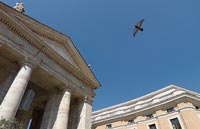© 2006 Giancarlo De Leo, All Rights Reserved.
(following article by Wikipedia)
St Peter's Square, or St Peter's Piazza (Piazza San Pietro), is located directly in front of St Peter's Basilica, in Vatican City, the papal enclave within Rome. The open space before the basilica was redesigned by Gian Lorenzo Bernini, from 1656 to 1667, under the direction of Pope Alexander VII, as an appropriate forecourt, designed "so that the greatest number of people could see the Pope give his blessing, either from the middle of the façade of the church or from a window in the Vatican Palace" (Norwich 1975 p 175). Bernini had been working on the interior of St Peter's for decades; now he gave order to the space with his renowned colonnades, using the Tuscan form of Doric, the simplest order in the classical vocabulary, not to compete with the palace-like façade by Carlo Maderno, but he employed it on an unprecedented colossal scale to suit the space and provide emotions of awe.
The massed accretions of the Vatican Palace crowded the space to the right of the basilicas's façade; the structures needed to be masked without obscuring the papal apartments. The obelisk marked a center, and a fountain by Carlo Maderno stood to one side: Bernini made the fountain appear to be one of the foci of the oval embraced by his colonnades and eventually matched it on the other side, in 1675, just five years before his death. The trapezoidal shape of the piazza, which creates a heightened perspective for a visitor leaving the basilica and has been praised as a masterstroke of Baroque theater is largely a product of site constraints.
The colossal Doric colonnades, four columns deep, frame the trapezoidal entrance to the basilica and the massive oval area which precedes it. The oval's long axis, parallel to the basilica's façade, creates a pause in the sequence of forward movements that is characteristic of a Baroque monumental approach. The colonnades define the piazza. The oval center of the piazza, which contrasts with the trapezoidal entrance, encloses the visitor with "the maternal arms of Mother Church" in Bernini's expression. On the south side, the colonnades define and formalize the space, with the Barberini Gardens still rising to a skyline of umbrella pines. On the north side, the colonnade masks an assortment of Vatican structures; the upper stories of the Vatican Palace rise above. At the center of the oval stands an Egyptian obelisk, forty meters tall to the cross on its top. The obelisk, of the 13th century BC, was moved to Rome in the 1st century to stand in the central spina of the Circus of Nero, which lay to the left of the present basilica. It was moved to its current site in 1586 by the engineer-architect Domenico Fontana under the direction of Pope Sixtus V; the engineering feat of re-erecting its vast weight was memorialized in a suite of engravings (illustrated left). Though Bernini had no influence in the erection of the obelisk, he did use it as the centerpiece of his magnificent piazza.
The paving is varied by radiating lines in travertine, to relieve what might otherwise be a sea of cobblestones. In 1817 circular stones were set to mark the tip of the obelisk at noon as the sun entered each of the signs of the zodiac, making of the obelisk a gigantic sundial's gnomon.
Europe / Holy See (Vatican City)
Lat: 41° 54' 9" N
Long: 12° 27' 28.8" E
Precision is: Medium. Nearby, but not to the last decimal.



 Tap or click the zoom icon in the bottom right corner of the picture to switch between in-page and fullscreen view
Tap or click the zoom icon in the bottom right corner of the picture to switch between in-page and fullscreen view